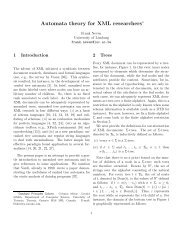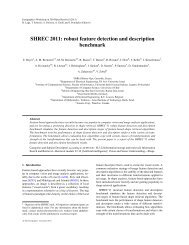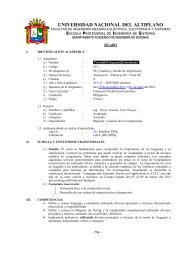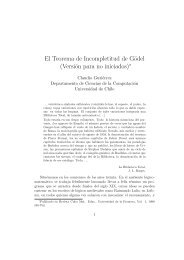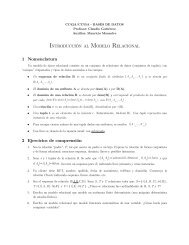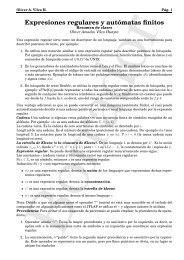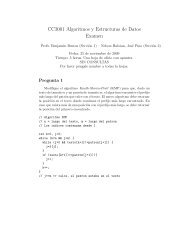Parameterized Regular Expressions and Their Languages
Parameterized Regular Expressions and Their Languages
Parameterized Regular Expressions and Their Languages
Create successful ePaper yourself
Turn your PDF publications into a flip-book with our unique Google optimized e-Paper software.
study of these expressions requires the development of new tools for underst<strong>and</strong>ing the lowerbounds of their decision problems.Whenweletvariablesrangeoverwordsratherthanletters, underthepossibilitysemanticsL ✸ we may obtain, for example, pattern languages [21] or languages given by expressionswith backreferences [22]. These languages need not be regular, <strong>and</strong> some of the problems(e.g., universality for backreferences) are undecidable [16]. In contrast, we show that underthe certainty semantics L ✷ regularity is preserved, <strong>and</strong> complexity is similar to the case ofvariables ranging over letters.Organization <strong>Parameterized</strong> regular expressions <strong>and</strong> their languages are formally definedin Section 2. In Section 3 we define the main problems we study. Complexity of the maindecision problems is analyzed in Section 4, <strong>and</strong> complexity of automata construction inSection 5. In Section 6 we study extensions when domains of variables need not be singleletters.2. PreliminariesLet Σ be a finite alphabet, <strong>and</strong> V a countably infinite set of variables, disjoint from Σ.<strong>Regular</strong> expressions over Σ ∪ V will be called parameterized regular expressions. <strong>Regular</strong>expressions, as usual, are built from ∅, the empty word ε, symbols in Σ <strong>and</strong> V, by operationsof concatenation (·), union (|), <strong>and</strong> the Kleene star (∗). Of course each such expression onlyuses finitely many symbols in V. The size of a regular expression is measured as the totalnumber of symbols needed to write it down (or as the size of its parse tree).We write L(e) for the language defined by a regular expression e. If e is a parameterizedregular expression that uses variables from a finite set W ⊂ V, then L(e) ⊆ (Σ∪W) ∗ . Weare interested in languages L ✷ (e) <strong>and</strong> L ✸ (e), which are subsets of Σ ∗ . To define them, weneed the notion of a valuation ν which is a mapping from W to Σ, where W is the set ofvariables mentioned in e. By ν(e) we mean the regular expression over Σ obtained from eby simultaneously replacing each variable x ∈ W by ν(x). For example, if e = (0x) ∗ 1(xy) ∗<strong>and</strong> ν is given by x ↦→ 1,y ↦→ 0, then ν(e) = (01) ∗ 1(10) ∗ .We now formally define the certainty <strong>and</strong> possibility semantics for parameterized regularexpressions.Definition 1 (Acceptance). Let e be a parameterized regular expression. Then:• L ✷ (e):= ⋂ {L(ν(e)) | ν is a valuation for e}• L ✸ (e):= ⋃ {L(ν(e)) | ν is a valuation for e}(certainty semantics)(possibility semantics).Since each parameterized regular expression uses finitely many variables, the number ofpossible valuations is finite as well, <strong>and</strong> thus both L ✷ (e) <strong>and</strong> L ✸ (e) are regular languagesover Σ ∗ .The usual connection between regular expressions <strong>and</strong> automata extends to the parameterizedcase. Each parameterized regular expression e over Σ ∪ W, where W is a finite4



